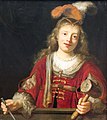Johannes Spilberg
Johannes Spilberg (30 April 1619 – 10 August 1690) was a German Baroque painter, active in Amsterdam during the period known as the Dutch Golden Age.
Life
Spilberg was born and died in Düsseldorf.[1] He learned to paint from his father, who painted in oils and on glass, who then sent him to Antwerp, to learn under Rubens.[2] While underway, he heard that Rubens had died, so he settled in Amsterdam and became apprentice to Govert Flink, a student of Rembrandt, for seven years.[2] He won a commission for a schutterstuk from the Burgomasters of Amsterdam that still hangs in Amsterdam. In Amsterdam he married Marrite Gerrits in 1649.[1]
He worked for years as family portrait painter for Johann Wilhelm, Elector Palatine. His uncle Gabriel was court painter for Charles II of Spain.[2]
Though he worked in Düsseldorf, he kept his family in Amsterdam, since he was traveling with his patron most of the time anyway.[2] He taught his daughter Adriana to paint, and her talents became so well known, that she was offered a position in Düsseldorf as well.[2] Her father wanted her to marry a painter, however, and felt her chances were higher of finding a good one in Amsterdam.[2] Eventually, she did marry the painter Willem Breekveld in 1684, but he died in 1687.[2] After Spilberg's death, she married his successor in Düsseldorf, Eglon van der Neer in December 1697.[2]
He is known for portraits, landscapes, and historical allegories in the Rembrandt school.[1]
Gallery
-
1644 religious painting of Jael with her hammer and nail, style of Flinck, collection Gemäldegalerie Berlin
-
The Feast of Esther by Johannes Spilberg the Younger
-
Family of Sophia Eleonore of Saxony, 1667.
References
- ^ a b c Johannes Spilberg (II) in the RKD
- ^ a b c d e f g h Johannes Spilberg biography in De groote schouburgh der Nederlantsche konstschilders en schilderessen (1718) by Arnold Houbraken, courtesy of the Digital library for Dutch literature
External links
- Johannes Spilberg on Artnet



